The Key To My Heart
Terryville section of Plymouth (Google Maps Location)
May 28, 2009
Come. Come with me on a journey into the mind of a madman. No, not me, but Tom Hennessey – the guy most responsible for the wonderful insanity (some blowhards would say inanity) of the Lock Museum of America. At the outset you should know… This museum contains nothing but locks. Okay, there are keys too, but that’s it. Nothing else. At all.
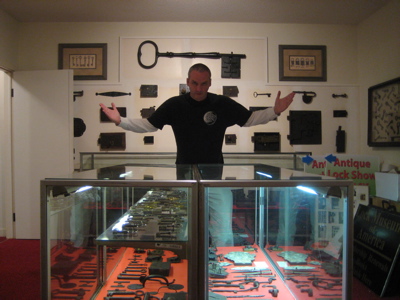
And I loved it. So did Dan, who was wrapping up his day long CTMQ adventure with me out here in Terryville at the lock museum. After a full day of museum going (you can see our itinerary for his profile of me here), Dan was positively giddy (and a bit punchy) nearing the end. For my part, I was quite happy too.
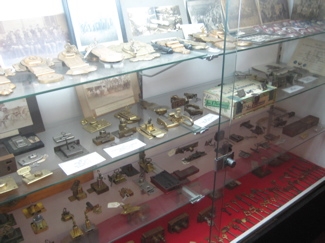
Why? Because I had shown Dan a solid day of what this website is all about. We went to a wide variety of museums, met some wonderful docents, learned a bunch of stuff we didn’t know we cared to learn and here, at the lock museum, it all came together for him (I think). Totally random, singularly devoted to one subject (Locks!), and decidedly quirky, I had created a convert in Dan. He grew up in Connecticut and went to Yale, but like 99% of the public, had never really delved into the seemingly mundane to find the exquisite. Now he had… And like I said, he was loving it.
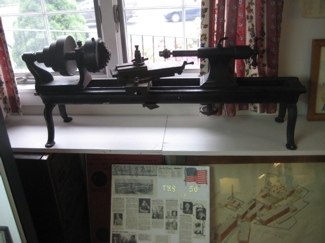
Not that either of us gives a hoot about locks. They are merely functional and important little pieces of hardware that we navigate several times a day without thinking about them. We lock our houses with tumbler locks. Our cars with automated locks. We get into our office buildings with magnetic strip reader locks. Unlock our desks with little crappy key locks. And thankfully there are those out there who find beauty and historical significance of these things to the extent that they’ve put together an incredibly large display of them in a museum setting.
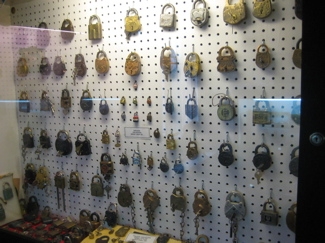
I shouldn’t have been surprised at the size of the collection. After all, I was wowed a few miles away at the American Clock & Watch Museum in Bristol just a month prior. (CTMQ Visit here.) Here in the industrial heart of Connecticut, where brass implements (Waterbury), clocks (Bristol/Waterbury), machine parts (New Britain) and locks (Terryville, New Britain) were made for national and international markets for years, there is a rich history of these things and several museums celebrating each towns’ past.
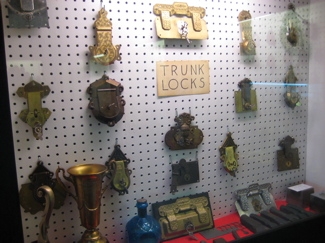
Which reminds me… 107 museums ago, way back at my very first museum visit at the New Britain Industrial Museum (CTMQ Visit here), I had made a deal with the tour guide there. While showing us the comparatively small collection of Russwin and Corbin locks there, the guide had complained about the Lock Museum saying something about how they got a huge amount of grant money whereas the Industrial Museum got nothing.
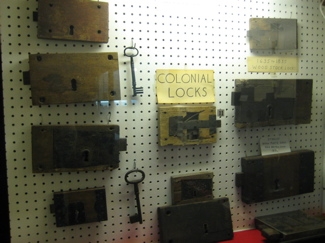
I promised him that when I made it out to the Lock Museum that I’d give them the business and ask them to donate some of their New Britain made locks to the Industrial Museum. I was totally prepared to do it too… But as you’ll read, that turned out to be an impossibility.

Built on the site of the original Eagle Lock Company, which began making locks in 1854, the Lock Museum of America chronicles lock-making history–a chapter in mechanical engineering lore. The eight display rooms house more than 23,000 kinds of locks, including vault locks, door locks, and padlocks.
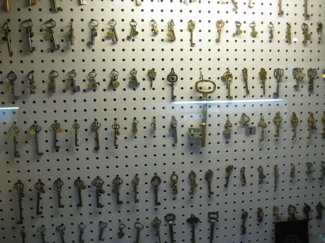
Think about that for a second. Twenty-three THOUSAND locks. As you can imagine, The Lock Museum of America holds the largest collection of colonial and antique locks in the United States. I told you, this place is awesomely insane.
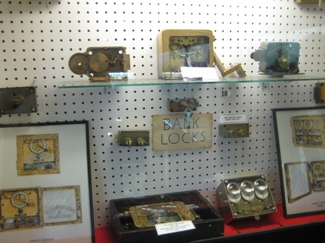
Dan and I entered, paid the entrance fee and were guided by an older woman to the center of the first room. The museum is impeccably neat and obsessively organized – as it must be. As Dan and I spun around in wonderment at the locks before us. At this point, I think we thought that this room was the entire museum, which would have been more than enough. Little did we know that this was only about a third of the collection.
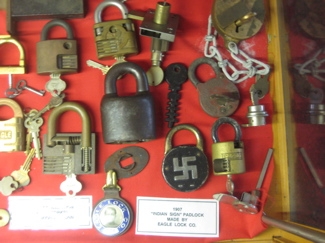
The woman smiled at us, walked over to a wall panel and pushed a button. The next thing we knew, we were being “guided” by the pre-recorded voice of (I assume) Tom Hennessey. This was a first for me: A tape recorder tour guide. Not only that, but the gravelly recorded voice emanating from the tinny speakers was unintentionally hilarious.
Even though the kindly woman had probably heard the recording a thousand times, she couldn’t contain her laughter at the disembodied voice of (I assume) Mr. Hennessey. The recording could have used a couple retakes at certain places, like when “the voice” would suffer a coughing fit or stumble hopelessly on a phrase.
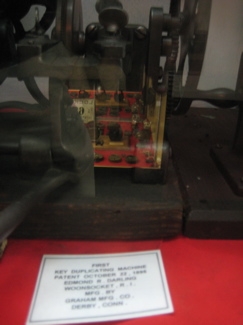
The first key duplicating machine!
It was pretty funny, but c’mon… The narrator sounded like he was 115 years old and he was clearly passionate about locks. What more could a museumgoer ask for? The lady took leave of us and we were free to enjoy the tour, such as it was, on our own.
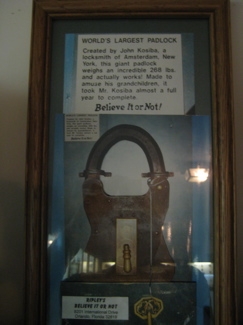
The world’s largest padlock!
At this point, I think I could easily get away with simply posting 30 pictures of locks and be done with it. I didn’t take any notes during my visit because really, I think all they would say is “locks, locks, locks. Locks, locks, locks. More locks! Morlocks?”
Yeah, now that would be cool. Sort of a melding of the Clock & Watch Museum with the Lock Museum! Morlocks are cool. (Morlocks are a fictional species created by H. G. Wells for his 1895 novel, The Time Machine. They dwell underground in the English countryside of A.D. 802,701 in a troglodyte civilization, maintaining ancient machines that they may or may not remember how to build. Their only access to the surface world is through a series of well structures that dot the countryside of future England.
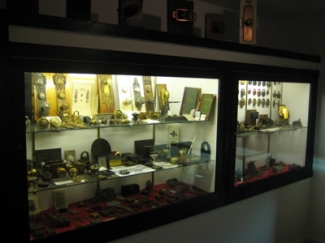
Morlocks are humanoid creatures, said to have descended from humans, but by the 8,028th century have evolved into a completely different species, said to be better suited to their subterranean habitat. They are described as “ant-like”, because they possess the ability to crawl up walls.
Morlocks wear no clothing but are covered with fur. As a result of living underground, they have little or no melanin to protect their skin, and so have become extremely sensitive to light.
I always appreciated Wells’ foresight and intelligence to set The Time Machine so far into the future. Anyway, there were no Morlocks at the Lock Museum, and this aside has now gone on too long. Let’s look at some real locks already.
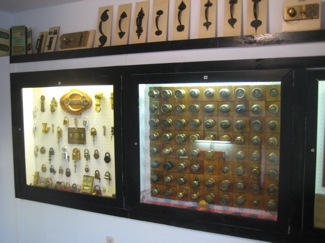
As I said, the museum boasts eight display rooms. This first one contains 23 different displays and “The Voice” walked us through each one, which as it turns out, is a pretty efficient way to go. I found myself rather enjoying it and even if you get lost in one particular bunch of locks, you can catch up with “The Voice” later as each display is numbered.
In a nutshell, the first floor contains displays containing Eagle Locks, trunk locks, padlocks, keys, cabinet locks, bank locks, colonial locks, Branford Rim locks, auto locks, old key machines and the museum hall of fame.
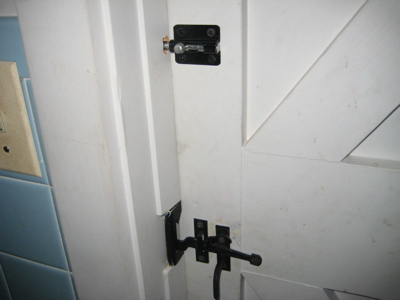
The museum’s bathroom door lock
And I must mention the various collections around the room which contain – you guessed it – more locks.
Before heading upstairs to check out some more, um, locks, let’s learn a little bit more about one of the driving forces behind this singularly devoted place. (Info taken from some Bristol Herald article reprint I picked up at the museum.)
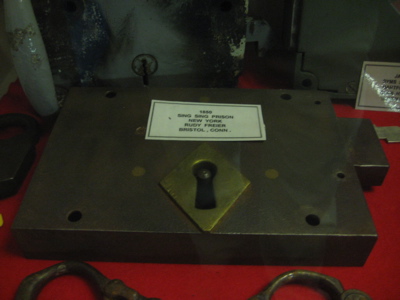
Old Sing Sing Prison jail lock
Tom Hennessey had a long career in the lock-making industry. Once retired, he didn’t stray far from his craft and is still involved with locks as much as he ever was. Heck, he even authored a book called Locks and Lockmakers of America.
“It’s become the bible of the lock industry,” Hennessey says. He could discuss pins, tumblers and keys for hours. (I believe it.) The cuts on a key push the pins. When they’re all lined up properly the lock opens. And, as proven by an ancient Egyptian lock at the museum, the fundamental design has remained the same for at least 4,000 years. “It’s like a knife, fork or spoon,” he said. “It won’t change.”
Once upon a time, lock manufacturers prospered in Terryville, New Britain, New Haven. “Connecticut was the center of lock making,” Hennessey explained.
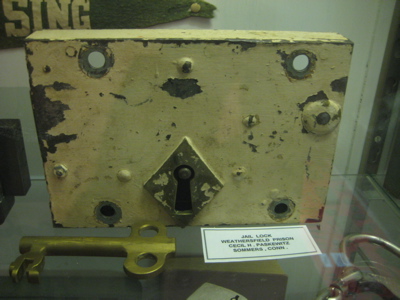
Jail lock used in Wethersfield’s old prison (CTMQ “visit” here)
In Terryville, the landmark Eli Terry Jr. Water Wheel was used to operate machinery at one of America’s first lock factories, Lewis Lock Company, in the early 1850’s. It is the only known original manufacturing water wheel left in the country. CTMQ notes: I can’t believe I didn’t make the two block trek westward to check it out. I have driven by it and will certainly make a trip out there soon and update this page. This 20-foot-in-diameter water wheel has a gear around the circumference that adds speed to the shaft which was used to operate the machinery of the factory.
Hennessey was one of the founders of the lock museum and has been curator since it opened in 1972. The museum has grown from a small storefront to the eight current rooms.
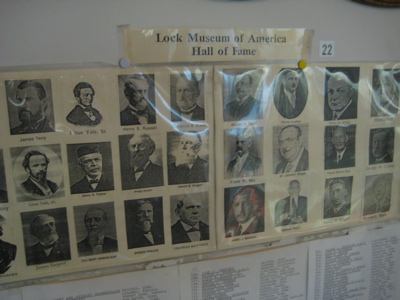
Yes folks… The lock Hall of Fame
Hennessey recently received a box from a Burt Spilker of Baltimore with over 300 keys and assorted locks. Some are over 1,000 years old and date back to Roman times – the collection is valued at around $300,000.
Holy cow. Lock that thing down!
Going back to the Industrial Museum’s lament, the lock museum got a $50,000 contribution from the Yankee Securities Convention, which is some sort of lock group.
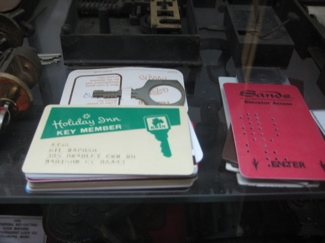
And check this out: Hennessey’s lock expertise has taken him on some interesting travels. He set up the key systems at SMU in 1963 and saw President Kennedy’s motorcade pass by about five minutes before he was assassinated. He also set up the key in system for the World Trade Center which had 46,000 Corbin locks. Hm, maybe this guy should stop traveling.
Let’s go upstairs.
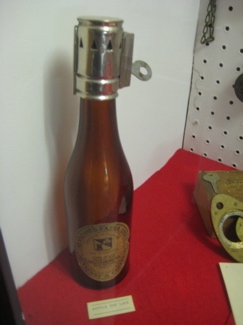
Beer lock!
The newest room exhibit is an extensive lock collection that includes a Cannon Ball Safe, 30 early era time locks, Safe Escutcheon Plates and a large number of British Safe Locks, Door Locks, Padlocks, Handcuffs and Keys. Another display room, known as The Eagle Lock Company Room, contains over 1,000 locks and keys manufactured from 1854 to 1954.

Independence Hall replica lock and key!
The Bank Lock Room comprises a selection of bank locks, vault locks, safe locks and time locks. The Corbin-Russwin Room contains a large display of ornate hardware. Several pieces are gold plated and enameled. One of the animated displays shows how a pin tumbler lock works.
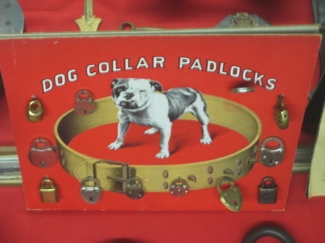
Recently added is a large, 20′ long display of mounted door knobs and escutcheons made by Russwin and P & F Corbin during the Victorian era. These are extensively detailed in styles such as Roman, Greek, French and Italian Renaissance, Gothic, Flemish, and Elizabethan English.
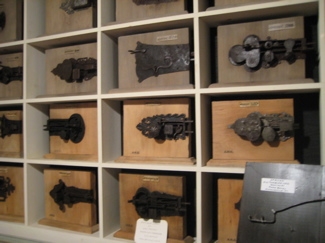
The Yale Room accommodates locks manufactured by the company from 1860 to 1950. One of the attractions here is the original patent model of the Mortise Cylinder Pin Tumbler Lock designed by Linus Yale Jr., in 1865. While this device is considered the greatest invention in the history of lockmaking, it is certainly not without historical precedence. Close by is that 4,000 year old Egyptian made pin tumbler lock.
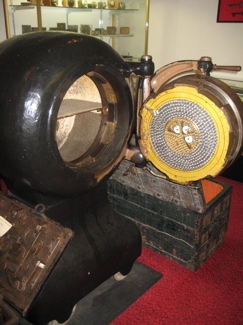
There is also a large display of locks and hardware made by Sargent and Co. in New Haven, Ct. Several early exit devices and door closers are on display as well.
And finally, the Antique Lock Room contains a large display of colonial locks and Ornate European Locks dating back to the 1500’s.
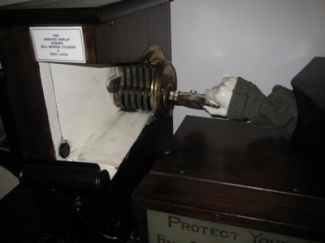
You get the point. There are a lot of locks at the Lock Museum of America. Perhaps my favorite little display in the whole place is the front gate lock from none other than the Lock Museum of England! Yes, the two venerable institutions traded door locks to display in each other’s museums a couple decades ago. I don’t know why, but that cracked Dan and me up.
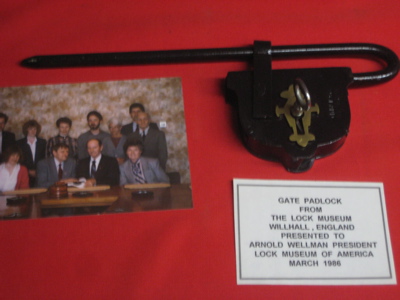
The one, the only… Gate lock from the Lock Museum of England!*
*Update! Just found this on the Intertubes: Willenhall (in England) is famous for the manufacture of locks, and the UK’s National Lock Museum was situated within the town until it closed in December 2008 due to the withdrawal of funding by Walsall Metropolitan Borough Council. I’m actually somewhat upset by the news… And I just emailed it to Dan too. We care.
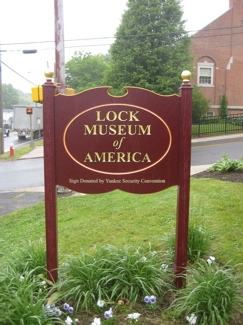
As you can clearly see from my pictures, if locks are your thing, this is your heaven. And apparently Dan likes locks. The time was getting late and we had to get back through Bristol to Farmington to pick up Damian, but Dan just didn’t want to leave. He was furiously taking notes (and I took none and yet was able to craft this wonderful posting) and smiling at each new lock discovery.
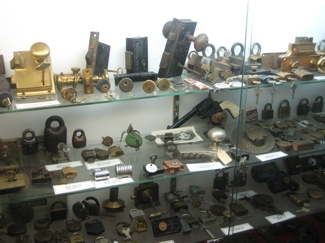
At the least, I can say that Dan surely told someone about his visit to the Lock Museum and for that, I can be happy. I’ve successfully indoctrinated another person into my crazy world.
Lock him up and throw away the key. And now, some more pictures (you won’t believe how many I didn’t include.)
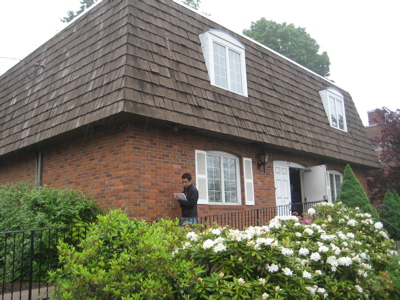
![]()

 miguel sartori says
miguel sartori says
February 27, 2010 at 9:11 pmhi,, i bought an old trunk,, undernis dirt, i found one the locks you have in your trunks lock, is th eone exatly under the sign trunk locks in picture number five,, could you addres me in how to get more information about lock, will love to have an idea of how old the trunk is…
thankyou so much!!!
great idea the museum of locks!! is an anusual databank!!
best!!
Miguel Sartori
 Kip Maxwell says
Kip Maxwell says
March 16, 2010 at 1:31 pmHello,
Can you help me out?
I’m looking for a key for a CORBIN DESK DRAWER LOCK.
info on the back of the lock is, HB7.
This lock is also used on wwii u.s. feild desk.
Thank You,
Kip Maxwell
530-736-9153
 Steve says
Steve says
March 16, 2010 at 1:51 pmKip – You should contact the Corbin company, the Lock museum or even the New Britain Industrial Museum. This blog has nothing to do with either.
 John Darby says
John Darby says
July 28, 2010 at 11:57 amGreetings!
I love your collections! Very extensive!
Quick question: have folks created lcoks which a a bit Rube Goldberg? I am looking for something akin to the overly complex locks we see in Lord of the Rings or Hellboy2.
Thank you!
JohnD
 Steve says
Steve says
November 19, 2010 at 9:39 amWhy does this page get the most illiterates who fail to read even the first two sentences? Or the URL for that matter?
 Russ says
Russ says
December 5, 2010 at 5:24 pmWonderful site! Hope to visit on my next trip to Connecticut.
Grew up in New Britain and remember Russwin and Corbin locks, of course.
Trivia question: In which Hitchcock movie do Russwin keys play a big part because there’s a missing key from a keychain, and it’s of a different brand, making it obvious that a key is missing?
 frank j p says
frank j p says
December 29, 2010 at 1:21 amWOW ! (thank you)
 kerri says
kerri says
June 22, 2011 at 1:54 amYeah, so I bought this chastity belt and after locking it noticed I didn’t have the key. Is this something that Connecticut Museum Quest can help me with? I need to get a duplicate old key because I changed my mind about wearing this piece of antique equipment. I’m thinking this was designed in 1759, but how can one be sure?
…just kidding.
 D Locksmith says
D Locksmith says
July 19, 2011 at 1:15 pmI agree with Miguel, it is a very unusual databank! I never imagined that such a thing could exist. It would be interesting to see the old collections, the first lock systems compared to the actual ones. I have a very (very) old key at home, I have no idea when it was made… and I really don’t need it. Do you think it would be a good idea to donate it to the museum?
 Amanda says
Amanda says
August 24, 2011 at 12:44 amI have some really old locks and keys P & F Corbin New Britain CT. and the number on the back is 2207241 was wondering if you would know anything about it. I have locks and more keys but it is the only one that stands out they all have one number on them they look like skeleton keys anyways I hope to hear from you;)~
 gary S says
gary S says
September 26, 2011 at 10:48 pmI have a old 1700 skull and crossbone. Could you tell me how much its worth?
 cory sabins says
cory sabins says
October 9, 2011 at 2:41 amhi i have a very old key from The Eaglelock Co and i found it in my basement whinch was built in the 1800’s along with the church where i live. i was just curious what it may be worth or a story behind it.
 Steve says
Steve says
October 9, 2011 at 7:14 amI want you to jam the key into your eye as hard as you can. Only then will you see the true story behind that particular lock and key.
 Rachel says
Rachel says
October 16, 2011 at 6:37 pmpurchased a trunk. only identifying marks is the lock to help date trunk. eagle lock 410. any idea as to possible manufacturing date for my trunk? any ideas is better than the 1920’s im dating it as. thanks a bunch!
 Steve says
Steve says
October 17, 2011 at 9:36 amSeriously you people are just messing with me now, right? Rachel, PLEASE tell me you’re kidding by asking such an idiotic question here.
 jacks hobby says
jacks hobby says
November 1, 2011 at 8:20 amWow great collection.Good job dud..
 Steve says
Steve says
November 2, 2011 at 2:25 pmEven though it’s quite clear that this is not my collection at all? And how I repeatedly (yet endearingly) made fun of the guy who actually devoted his life to collecting locks?
 John McKenna says
John McKenna says
November 7, 2011 at 6:56 pmRecently we did a job, modernizing a home. The interior locksets on the doors, both passage & privacy were unknown to us. The cut outs were rectangular, & the locks consisted of knobs attached to a shrouded rosette & a latch. It slid into the cut out & secured by two retaining screws, one on either side of the lockset. There are no markings on the locks. We would be able to send you pics of the locks if you provide an address. Any help in identifying the locksets would be appreciated.
 Steve says
Steve says
November 8, 2011 at 2:29 pmWhat is a shrouded rosette? You see, I have no idea in the world because – as you’d know if you took 30 seconds to read more than the title of this page, let alone the comments where I have come to enjoy making fun of people like you – I don’t know crap about locks. In fact, it took me something like an entire hour to change a stupid doorknob in my house last year. I’m pretty useless with this type of stuff.
Though if you feel compelled to send me pictures, I’d prefer they be of hot Latina women and not some boring old lock thing.
 robert mccrary says
robert mccrary says
November 16, 2011 at 2:07 pmDo you know a site that has all of the Eagle Lock co key blanks listed with a possible photo included? I have an oold Eagle lock but no key and a difference of opinion with the local locksmith about what kind of key it might require. If I could get an image…or a description, I might be able to make a key. But, all sites I visit do not list this number. 3ZQ8
Thanks.
 Steve says
Steve says
November 16, 2011 at 2:31 pmMe? I’d probably seek out an Eagle Lock Co site and not a goofy blog written by a guy who spent half the page above making fun of people who care about old locks.
I would like to thank you, though, for continuing this maddening trend of lock-lovers proving themselves to be weird.
 Bill Cunningham says
Bill Cunningham says
November 16, 2011 at 2:47 pmHey! I recently lost the key to my bike lock. If you could let me know where it is, I’d appreciate it.
 robert mccrary says
robert mccrary says
November 23, 2011 at 7:36 pmI am trying to locate a source for Eagle Lock Company key codes. I have a lock that is missing a key and every locksmith I have been to tells me that the code for that key cannot be found. The lock is very definitely made by Eagle Lock CO. The code is 3ZQ8. It appears that there was an over strike on the letter “Q”, so it could be a G. This lock is on an old metal lock box. Very secure. The lock is a half mortise lock measuring 1 3/4″ X1 1/2″. Can you direct me to a source for Eagle lock codes…..please?
 Steve says
Steve says
November 23, 2011 at 9:42 pm“Every locksmith tells me that the code for that key cannot be found” so I turn to a website about museums and other items of interest in Connecticut named “Connecticut Museum Quest” and a page where the author has posted numerous comments making fun of his readers who failed to read 3 sentences on this website before making their comments.
Including one just a week or two ago directly making fun of you, Robert McCrary.
The human race is doomed.
 angel says
angel says
December 10, 2011 at 8:51 pmi have a corbin cabinet lock co padlock with key the key number is k127 and the key also has on it corbin new britain ct usa we could not find a date and would like more info on it if you ccould please let me know anything about this lock would be great i can send a picture of the lock if you can give me an email address thank you angel
 Steve says
Steve says
December 10, 2011 at 9:42 pmI checked. The above moron named “angel” found this site, which doesn’t have the words “corbin” or “lock” in the url via ask.com. He or she landed on the Industrial Museum page, then searched the site for their stupid lock and came to this page.
Unbelievably, he or she spent NINE minutes on this page before submitting the idiotic question above. So even though they were on this page for NINE MINUTES, they failed to read a thing, let alone the comments.
It’s official – lock nerds have taken over from the button nerds on the Button Museum page as the biggest idiots of the nerd collector word.
Congratulations.
 Tom Marquette says
Tom Marquette says
January 2, 2012 at 5:39 amI’m looking for a nieseen 612a.
thank you for your time.
 Isaac says
Isaac says
January 18, 2012 at 6:19 pmThis is incredible. Seriously incredible. A wonderful webpage that was amusing as well as informative, and a spectacular comment page that has people looking at me strangely while I work/cackle.
 Morlock says
Morlock says
March 21, 2012 at 9:23 pmSteve thanks for the report, thorough documentation, and you sparked a rather entertaining discussion page. Strange how ppl use internet these days huh?
 Alex says
Alex says
April 6, 2012 at 6:27 pmI was searching for an answer regarding an antique key; however I stumbled across this page, and have spent I don’t know how long laughing my a** off at the stupidity of pretty much every person that has posted a comment. Thanks for making my day! Stupid people never cease to amaze…
 Rachel white says
Rachel white says
April 23, 2012 at 8:41 pmI have some p&f Corbin new Britain ct keys I have a few questions email me. ????
 Steve says
Steve says
April 23, 2012 at 8:52 pmSure, I’ll email you. But you won’t like it.
 ake faamasino says
ake faamasino says
April 27, 2012 at 12:39 pmhi i have these key.the name on the key is P.F CORBIN NEW BRITAIN CT,and there is a code on the key,so if you read the email,please get back at me.my email address is agnesbelford@yahoo.com,or you can call me at 20364787136.thank you.
 Rob Fonda says
Rob Fonda says
April 29, 2012 at 2:22 amMy daughter and I were out “treasure hunting” with our metal detectors one day and among the numerous other items of interest that we found was a miniature padlock about an inch or two down in the soil in a well-traveled dirt roadway between a couple of old sheds in a small town in North Carolina.
The body of the padlock is round, approx. 15mm across and 3mm thick. There are 3 rivets, one of which forms the hinge for the bail. On this bail, the words EAGLE LOCK CO. are imprinted on one side, and TERRYVILLE CONN. on the other side. There is a letter “U” following CT. but the rest is obscured by the hinge itself. I am guessing that was a part of “USA.”
Actually, we found two of these locks. We found the first one in this road that farm tractors traveled years ago. The second we found over 100 feet away close to the house presently on the property, built in 1953. It is adjacent to the site of the former grand old farm house that once stood close by. It was about the same depth in the ground.
I am trying to find a reference that might list or picture this particular lock so I can positively identify it. It is small enough to perhaps have been on a jewelry box or maybe even a diary.
How can I find a cross reference of old locks made in that area of Terryville?
Thanks,
Rob
 Dawn says
Dawn says
May 15, 2012 at 10:02 amI am looking for an old, though not antique Chicago key (H2810) and thought perchance you could guide me in the right direction to find one. It’s for a gumball machine. Do you have any constructive comments? Thanks
 Steve says
Steve says
May 15, 2012 at 11:49 amSorry. I am actually incapable of constructive comments on this page anymore.
 Janet says
Janet says
May 20, 2012 at 8:11 pmI have an actual question that follows actually reading your entertaining blog. I saw a would-be review of this museum that said they weren’t open their posted hours. Their website was last updated in 2010, and the phone numbers don’t work. Do you have any idea how to visit this place, or contact the guy that runs it? My kid is doing a project on locks, and the museum is about 2 hours away from us, so I thought it would be perfect, but don’t want to drive 2 hours only to have to turn around and come back.
BTW, you got really, seriously stupid questions from the interwebs up here.
 bill says
bill says
May 31, 2012 at 11:32 pmHi I have a question I was wondering if you might be able to help I have an old trunk with an eagle lock skeleton key when did the company start up do you have an idea of an era they would have made travel trunk locks ?
 alains says
alains says
June 13, 2012 at 5:06 pmI have a brass plated steel drawbolt lock “Eagle Co” on a wardrobe steamer trunk,about 80 yaers old .I would very much appreciate if you could help me find the corresponding key.There is no numbers or letters to identify the lock.
Would the Illustrated Catalogue,Volume n°46[Eagle Lock Co]1930 742pp+sup contain the information for lock identification and therefore the corresponding key number?
If so,how can I get to flip through the book on the internet?
Alains,Lyon,France
 Mike Kondrat says
Mike Kondrat says
July 9, 2012 at 4:38 pmFolks –I am looking for a replacement key for my old trunk made by the Eagle Lock Co. The number is a Eagle 56k2. I tried Brettuns Village web-site but they do not show it available. It is almost impossible to try and contact them– no phone # or e-mail address Help!!!
 Kathee Brashar says
Kathee Brashar says
July 11, 2012 at 10:41 amVery interesting site. My husband has a lock that looks very old. It is round,has Eagle lock Co.Terryville,, Connecticut and The name Emerald on one side. Seems like it would be worth something. What do you think ??? I have looked on other sites and can’t find one exactly like it.
 Reader from PA says
Reader from PA says
August 9, 2012 at 8:17 pmSteve, Thanks for sharing your love of locks. But mostly Steve, Thanks for the laughs!
 Carrie Lynn says
Carrie Lynn says
September 13, 2012 at 4:22 amSteve, It’s painfully obvious that the majority of the population cannot read/comprehend, so I would suggest 2 options: 1. disable the comments for your blog, or 2. keep telling the idiots how obtuse they are, as they are probably not reading what you write in any event.
I think the museum is cool, cause I like funky things-and I really admire your restraint in your comments…mine would have been much worse!
:)
 Lois P. Hoover says
Lois P. Hoover says
September 23, 2012 at 5:32 pmI have a P & F Corbin key, CR 1909796. It appears the Lock Museum has many keys but if they are being collected by number, would this be an addition to the museum? Not for sale. I prefer to donate it.
 Bri L. says
Bri L. says
October 31, 2012 at 9:55 pmLois i have one of those keys as well.
 joan mcgarry says
joan mcgarry says
December 29, 2012 at 2:43 pmHello, I have a pair of pocket doors in my home – after removing the locking door pulls for cleaning I found a marking on the inside – Y&T inside of a clover leaf. I know this is a Yale and Towne marking but I can not find information on what years this logo was used. Would you know the time period Yale used this logo – I would love to how old it is? Thank you in advance for any infomation you might have. Joan McGarry
 Ken Mucherino says
Ken Mucherino says
January 10, 2013 at 12:25 pmRe:1926 Chevy Door Lock / Pillar Lock Eagle Key # CH 85
Lee Whitford Suggested I contact Tom Hennesy of the Lock Museum
Would you know of a source / locksmith for the corrugated key blanks or a CH85 key.
Lee gave me the 7 digit code. I am not sure of the key blank #???
Any Help Would be Appreciated. Ken Mucherino
 Julio Rey says
Julio Rey says
January 27, 2013 at 6:18 amHello, my name is Julio and I´m writing from Spain. I found an old lock and I can read in it: “eagle lock co. Terryville Conn. USA 7332”
I would like to know the year when it was made…could you help me?
Thanks
 Lynn Everhart says
Lynn Everhart says
January 29, 2013 at 4:36 pmI enjoyed the witty write up of the museum…. my husband and I will have to get there…. So many locks….. so interesting….who knew? And to have the subject of Morlocks thrown in as a bonus and a pun! Doesn’t get any better than that. Thanks again
 steve mcmullen says
steve mcmullen says
January 29, 2013 at 4:49 pmHi, I have just found a CORBIN CABINET LOCK COMPANY key cutting machine which is in a wonderful condition it has the CORBIN CABINET LOCK CO. NEW BRITAIN PATENT SEPT 6th 1910 plate attached to it. Everything is with it and it holds two huge drawers full of blank keys, maybe 1,000. It has numerous brand new cutting tools and one still packed in its original grease package.
Everything on it still works and is free moving.
Is this a museum piece.
Thanks.
Steve.